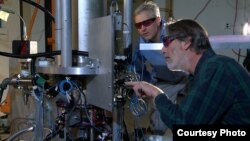U.S. researchers have launched a new atomic clock they say will neither gain nor lose a second in 300 million years.
The clock, called NIST-F2, will serve “new U.S. civilian time and frequency standard,” researchers at the U.S. National Institutes of Standards and Technology (NIST) in Colorado said. The current standard has been set by NIST-F1 since 1999.
Both clocks use what researchers call a "fountain" of cesium atoms to come up with a precise measurement of a second.
Since 1967, the second has been defined as the duration of 9,192,631,770 oscillations of the microwave radiation absorbed or emitted when a cesium atom jumps between two particular energy states.
"If we've learned anything in the last 60 years of building atomic clocks, we've learned that every time we build a better clock, somebody comes up with a use for it that you couldn't have foreseen," says NIST physicist Steven Jefferts, lead designer of NIST-F2 in a statement.
Last year, French researchers said they’d also developed a similarly accurate clock.
While losing a second every 300 million years might not seem important in daily life, many technologies such as telecommunications, satellite navigation and stock markets depend on incredibly accurate timekeeping.
Highly precise timekeeping has been integral to the development of the Global Positioning System (GPS) because of the high degree of synchronization required for satellites to triangulate a receiver’s location.
According to NIST, official time “is used to time-stamp hundreds of billions of dollars in U.S. financial transactions each working day.” NIST also said that as of 2014, they had received 8 billion automated requests to synchronize clocks in computers via its Internet Time Service. NIST also broadcasts time updates to around 50 million watches and other clocks.
The new super-accurate clock could have implications for theoretical physics in that it could allow physicists to see if nature’s constants do really do remain constant over time. Also, Earth-observation satellites could be improved because they would allow more accurate tracking of sea-level rise.
Last year, NIST said it had developed an ion clock that is believed accurate to within one second every 3.7 billion years, but it is not yet considered stable enough to use and requires more testing.
Here's a video about the clock:
The clock, called NIST-F2, will serve “new U.S. civilian time and frequency standard,” researchers at the U.S. National Institutes of Standards and Technology (NIST) in Colorado said. The current standard has been set by NIST-F1 since 1999.
Both clocks use what researchers call a "fountain" of cesium atoms to come up with a precise measurement of a second.
Since 1967, the second has been defined as the duration of 9,192,631,770 oscillations of the microwave radiation absorbed or emitted when a cesium atom jumps between two particular energy states.
"If we've learned anything in the last 60 years of building atomic clocks, we've learned that every time we build a better clock, somebody comes up with a use for it that you couldn't have foreseen," says NIST physicist Steven Jefferts, lead designer of NIST-F2 in a statement.
Last year, French researchers said they’d also developed a similarly accurate clock.
While losing a second every 300 million years might not seem important in daily life, many technologies such as telecommunications, satellite navigation and stock markets depend on incredibly accurate timekeeping.
Highly precise timekeeping has been integral to the development of the Global Positioning System (GPS) because of the high degree of synchronization required for satellites to triangulate a receiver’s location.
According to NIST, official time “is used to time-stamp hundreds of billions of dollars in U.S. financial transactions each working day.” NIST also said that as of 2014, they had received 8 billion automated requests to synchronize clocks in computers via its Internet Time Service. NIST also broadcasts time updates to around 50 million watches and other clocks.
The new super-accurate clock could have implications for theoretical physics in that it could allow physicists to see if nature’s constants do really do remain constant over time. Also, Earth-observation satellites could be improved because they would allow more accurate tracking of sea-level rise.
Last year, NIST said it had developed an ion clock that is believed accurate to within one second every 3.7 billion years, but it is not yet considered stable enough to use and requires more testing.
Here's a video about the clock:









